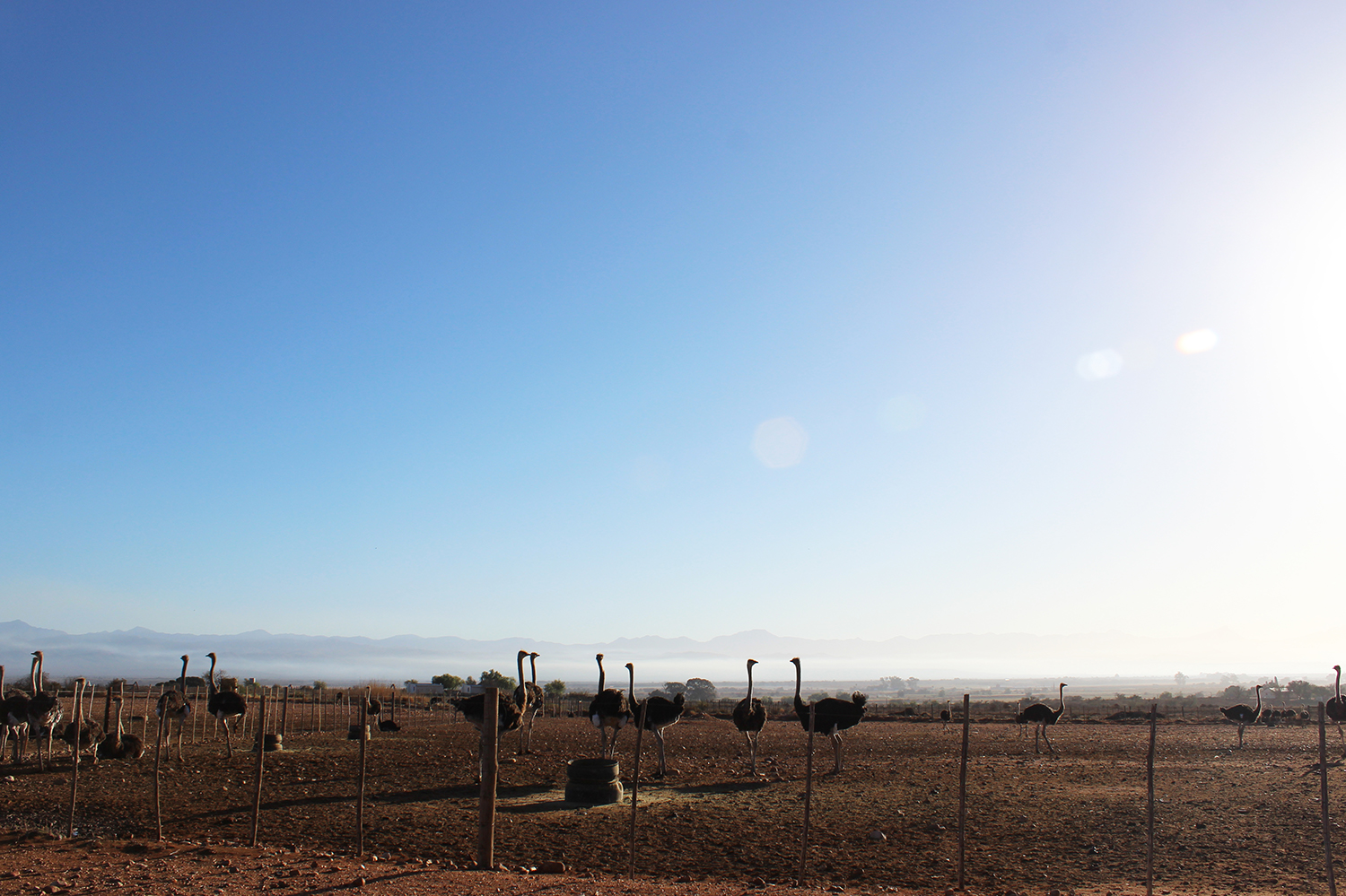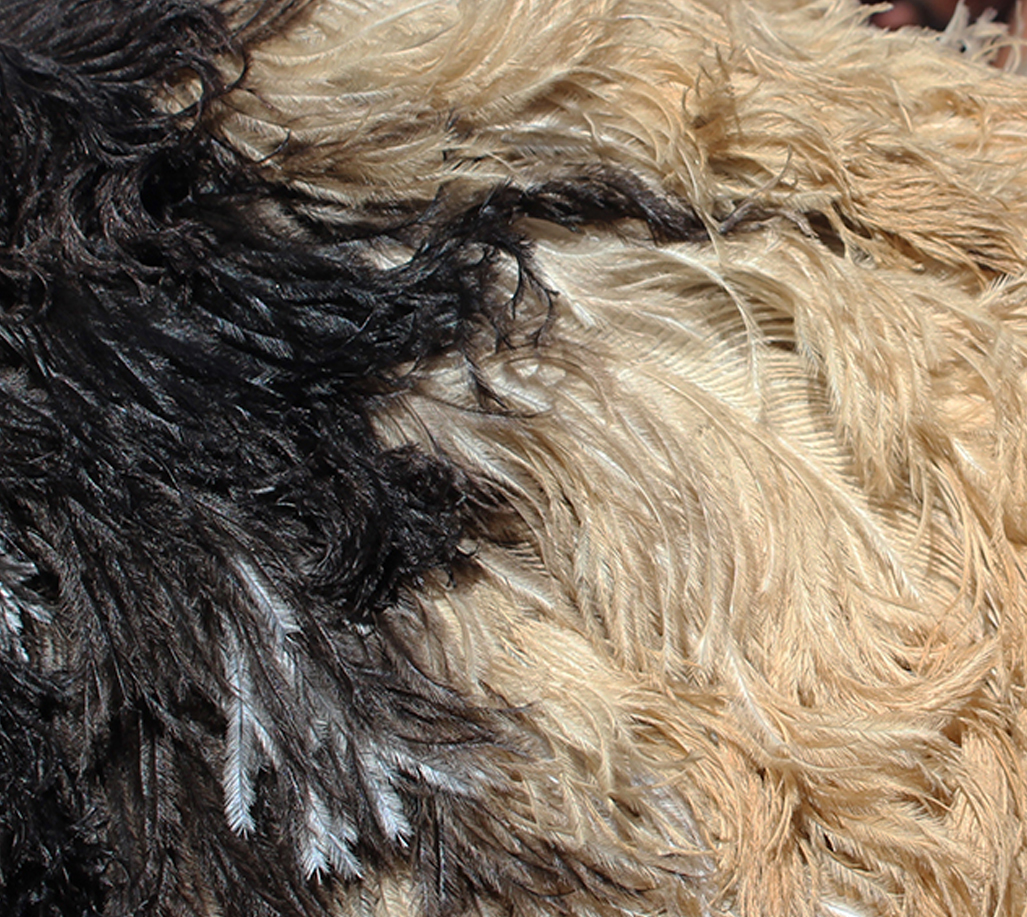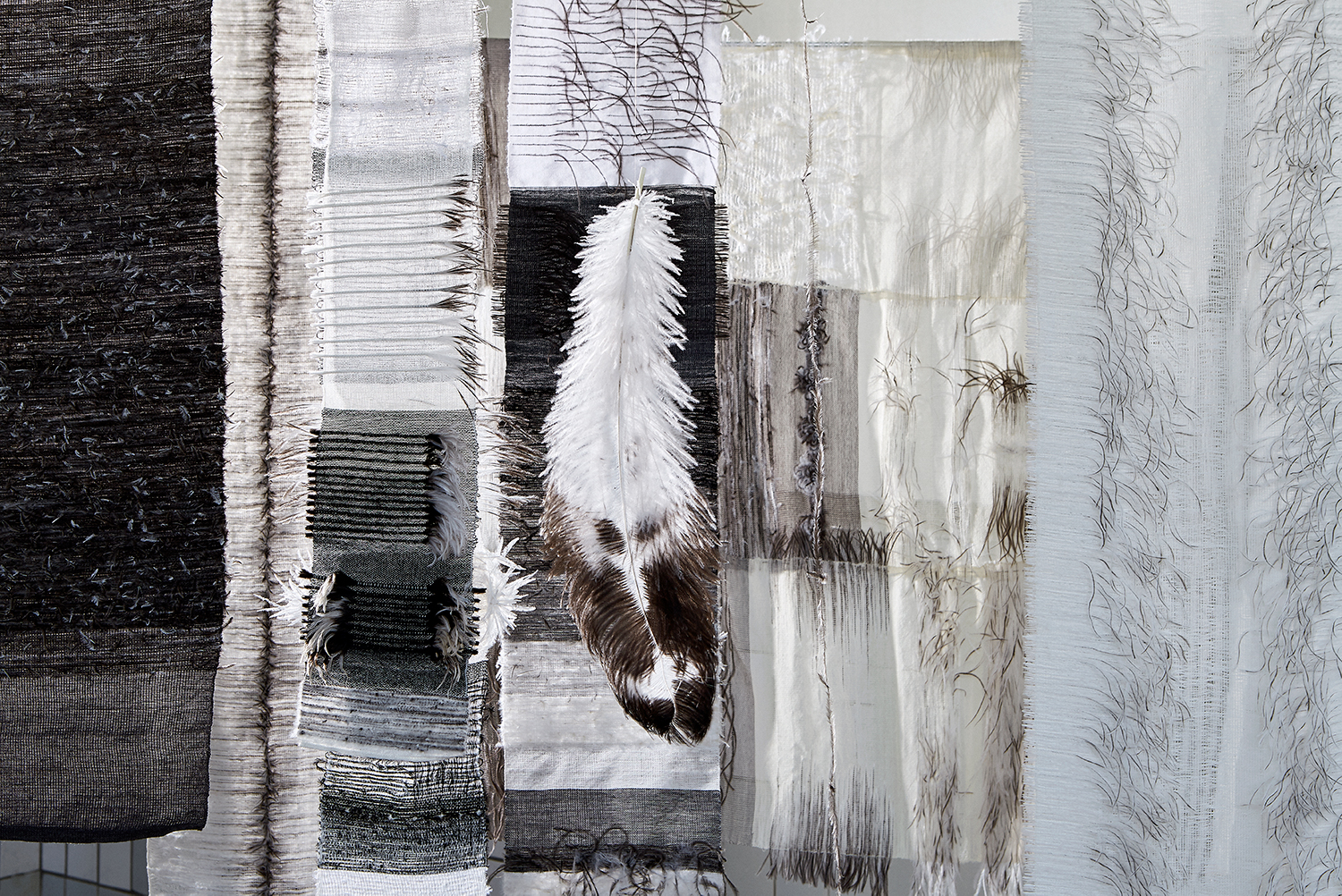Feathered Fabrics
by Pascale Theron
Pascale Theron presented Feathered Fabrics at Dutch Design Week 2018. The South African designer developed a hand-made fabric with ostrich feathers. According to the designer, as the feathers fall naturally and thus their use does not hurt the animal, this could be an alternative for wool, with a sustainable production and development to the local economy. In addition to a very soft and warm material, the designer is keeping the natural colour of the feather, each it is like a finger print, no two are alike.
Tell us about yourself and how you came to be an artist and designer? Where are you from?
I come from Johannesburg, South Africa. I have always been a creative person. My mother used to cover the walls of our home and let me go to town on these huge papered walls, I grew up in a very creative atmosphere. I actually initially thought I would become an artist, but after completing two years of Fine Art in a South African university, I realised that I didn’t want to focus so much on expressing my own feelings, but rather create design for others. Hence why I came all the way to Design Academy Eindhoven, one of the best design schools in the world. I had seen a few Design Academy graduates speak at the Design Indaba conference in Cape Town and I decided that is where I wanted to study. The projects were always so inspiring, out of the box stuff that no one else would even think to do, sometimes even crazy. I liked the Dutch mentality to design, it has a sense of humour, but still often has an important message that comes along with it.
Tell us about your experience in studying Design Academy Eindhoven?
I had a great experience at the Design Academy Eindhoven. For me it was the openness of the learning environment, encouraged by the mentors and teachers. They actively help you become your own individual designer, with your own process, style, voice and thoughts, something that I always felt was limited through the way the South African schooling system works. Also the internationality of it, I made friends from all over the globe, something that never would have been possible if I were still studying Fine Art in South Africa.
What are your plans now that you graduated?
Now that I have graduated I am working towards a visa to stay longer in the Netherlands, as well as starting up my own things. Freelance work, such s illustration I vey much enjoy to do, but I also have been doing a few talks about my graduation projects, which I love to do. The more people I can reach the better for me. I want to get my message out there, not only through these talks, but also through workshops, integrating others, institutions showing my work.
Do you have a creative process?
I usually draw inspiration from my own memories, knowledge and experiences in combination with the brief. It involves a lot of research, and that not only includes online, or in books, but also talking to people. I think my favourite part of the process is getting to integrate myself. Going into the communities, talking to people, speaking to the professionals, just being curious seeing where each lead takes you. My biggest issue is that I often have too many ideas (sounds very un-modest of me). I find it hard to let go of them, as I become so invested into it, that it becomes very personal. Eventually I come to what I feel is the strongest idea, and then the second fun part comes with producing, making the project a reality. I trust my intuition a lot with all the decisions I make throughout the design process, I know what I do and do not like, I’m quite hard-hard-headed that way!
Can you share a bit of your day-to-day work as a designer?
Most days (currently after graduating) I spend either answering emails, sending out applications to freelance work, competitions, institutions and anything else I find interesting for me and my work. The second part of my days are usually used up by producing things, whether that is weaving on my loom, experimenting, illustrating, doing graphic work, working through my website and portfolio, and any other fun side project I now finally have the time for after graduating.
How long did you take to develop the project Feathered Fabrics ? And what was your main inspiration?
It took me a year. I actually took extra time to complete my graduation, but not because of my Feathered Fabrics as much as my other graduation project. However, it was a tough process, there was a stage within the project where I sat down with my mentor, for our weekly feedback, and he basically gave me an ultimatum. Up until this point I was experimenting with the feathers and I just struggled to break the image of this iconic feather, that was so well known throughout history. I had to either get this project to a place where it was going beyond the feather, or it would be scrapped. I think this is what pushed me, I have a hard time letting go of my design darlings, so I fought for my feathered fabrics and ended up with what you see now.
We talked in Dutch Design week that your project is a sustainable product and good for the environment. Could you explain me it?
Currently in the worldwide ostrich farming industry, the ostrich’s main purpose is to be slaughtered after only one year for their meat and leather. By personally spending time in Oudtshoorn, South Africa talking to farmers and locals, the issue was clear that there was a need for change within the ostrich farming industry, as more and more of our farmers are selling their birds off and replacing them with sheep. Ostriches are also one of the easiest and least harmful on the environment in terms of farming industries. Compared to the beef industry, the birds are native to the land in South Africa, living in the deserts happily. They eat very little grain, and that which they do eat, is not harmful either, as it grows in other nearby towns. Unlike the sheep or beef industries, where there is a lot of grain or grass needed to feed these animals, and they produce a lot of waste in comparison to the ostriches. Introducing an alternative industry where the ostriches are only kept for their feathers, could mean that they could live their full lifespan while providing feathers without deterioration in quality for up to 35-40 years. Only the natural un-dyed feathers are used. Collecting feathers from the ostrich is the removal of dead material and is the equivalent to cutting fingernails causing no pain to the bird.
What technique did you use?
By removing the hard central shaft, and using the soft, thread-like barbules, the feathers can be combined to make a yarn that is then woven into a fabric. I use the barbules in a variety of ways, playing with the natural tones, fluffiness and length of the feathers. Each feather is different, each like a fingerprint, this is something beautiful that I use to my benefit in the feathered fabrics.
I was impressed by the delicacy and softness of the fabric touch that you developed. Do you believe this product to be used on a daily basis? or substitute some other material?
The breathable, washable, soft, warm and incredibly light weight qualities of the feathered fabrics mean it can be used in a variety of practical ways; as a functional interior textile (e.g. curtains, wall hangings, blankets), or as a more sustainable, animal-friendly solution to the fur industry. Because the Ostrich has no oil glands, it actually means they are not waterproof feathers like most birds, and hence means you can wash it. The feathers are quite strong, despite what most people think, but by combining the feathers along with the cotton, through the weaving process, it strengthens the feathers and gives them a strong base too.
How do you see the Feathered Fabrics , what is the future of it?
From now on, I would love to work with fashion designers to get the ball rolling. Working with equally minded designers who are just as passionate about sustainability and the beauty of the handmade as I am. Then I know there is a demand for such a material and we can work along with the local ostrich farmers, the feather processing factory, and the weavers to create the product. It’s not just up to me, it involves quite a few parties and very passionate people, who see the possibility in this material as much as I do. The aim of the project is to bring the manufacturing back to Oudtshoorn and actually have the feathered fabrics locally produced in the place where it all began. Giving back to not only the animals, but also all the locals who rely not here animals so much.
To create the project did you have many failures or negative feedback? What was your reaction to this?
My most common negative response comes from people who immediately assume the birds are being hurt to collect the feathers. This for me is important to make clear, that actually by farming the ostriches for the feathers instead of their meat and leather, we actually are ‘saving’ them from a very premature death. The animals get to love upwards of 40 years in their native land roaming the Karoo desert, and as mentioned before the harvesting fo the feathers is actually the removal fo dead materials hat would fall out naturally anyway if left. The reason they do cut the feathers though is to save the quality of the feather, because it gets damaged in the desert fields, and blows away. The other thing is people asking if this is really something new. I want to point out that the fundamental difference between my feathered fabrics and the way in which ostrich feathers have been used in fashion is in the application. Using the feathers within the fabric, differs from current use of feathers, where they are typically just sewn or glued on top of fabric. I use the feathers as a material to create the fabrics, just as you would use a silkworms cocoon to spin silk and then weave it to create a fabric. In all the ways feathers are currently being used it is always at a distance from our skin, there is always this layer of fabric between the feather and our skin (e.g. in our bedding we have feathers in our duvets between fabric, or in high end fashion he feathers are always applied as decoration onto another fabric). I was like, why do we do this when the material itself is so soft, warm and light without the need for another fabric?
You would like to add a question or add more information about you and the project?
The ostrich feather was once a highly valued commodity during the 19th Century, as Victorian and Edwardian woman decorated their flamboyant hats. Since then, the feather has fallen from grace and now is mostly used to remove dust or dyed for tacky carnival costumes. I aim to enhance the value of the ostrich feather, a very specialised product coming from the 150 year old ostrich feather industry that exists in Oudtshoorn, South Africa. I hope to go beyond the aesthetic and decorative and rather return it to its former glory in a more integrated and practical way. By harnessing the qualities of the feathers and creating a new craft through these feathered textiles, it could not only save many animals lives, but also could create a new industry of economic value to the small deserted town of Oudtshoorn.
INFO
Project and Words:
Pascale Theron
PHOTOS: Pascale Theron






